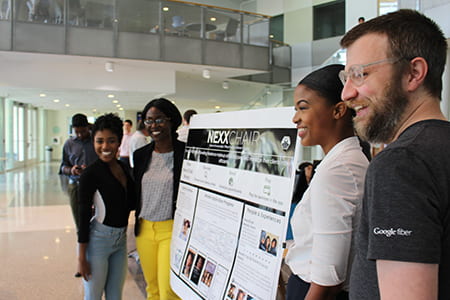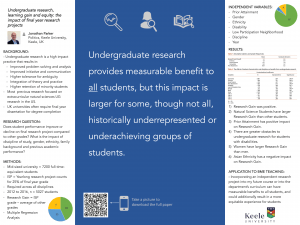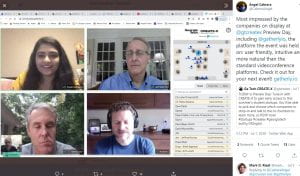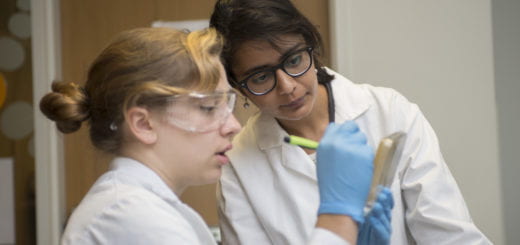Graduate students practice presentation and networking skills at online poster session

Becoming familiar with the scholarship of teaching and learning (SoTL) helps future faculty know where to look for answers to common teaching challenges and, just maybe, reveals opportunities to incorporate action research on their own teaching into their future scholarship.
In CETL 8713, the first course in the Tech to Teaching certificate, students typically select an education research article to present in class. By searching the literature for a teaching topic of interest in their discipline, students became familiar with the major journals publishing education research in their field, learn to identify quality empirical articles, consider the strengths and weaknesses of study designs, and reflect on how they might leverage the selected intervention in their own teaching.
In a traditional semester, I would have students present their articles during class. Hoping to avoid a round of passive presentations, I wanted instead to develop an online poster session. While the SoTL literature is new terrain for most Georgia Tech students, I knew that creating and presenting posters would be a familiar activity. If they had not yet presented their own research poster, the practice would be especially useful. I scaffolded the assignment by providing an asynchronous lesson about searching for SoTL literature and presented a sample poster of my own during a synchronous class meeting. An asynchronous discussion board allowed students to share questions and solutions about how to design their own poster. The assignment instructions specified what information to include on the poster: the research question, the methods, the results, and a reflection of how they can use the findings in their own teaching. Students prepared a 5-minute presentation to accompany their digital poster.

Poster presented by Katie Young, Ph.D. student in biomedical engineering about her selected article: Parker, J. (2018). Undergraduate research, learning gain and equity: The impact of final year research projects. Higher Education Pedagogies, 3(1), 145–157. https://doi.org/10.1080/23752696.2018.1425097
The only thing left to do was figure out how to facilitate the assignment virtually.
We use breakout sessions regularly throughout this hybrid course, but doing the poster session via breakout rooms felt too much like one-way presentations. I wanted to find a way to replicate the poster session experience.
I considered using an asynchronous model where students load their pre-recorded poster presentation into a discussion board post and then watch and reply to other posters asynchronously. I have judged posters presented this manner in the CRIDC and Postdoc Symposium and find it to be a useful way for participants to convey information, but it was missing the interactive component that my students have come to expect from our course.
I read another instructor’s blog about successfully hosting a poster session on Hubs (hubs.mozilla.com), a 3D virtual-reality-type platform in which users create an avatar and move around a virtual space. When I tested the platform with my CTL colleagues, I could see the potential for this type of program, but felt it was beyond my technical expertise to manage for this class.
I finally settled on a third-party provider, Gatherly, a social networking platform developed by a group of students, some of whom are enrolled at Georgia Tech. I divided my class of 24 students into 12 pairs and assigned each pair a virtual table. One partner presented their poster for the first 30 minutes of class and the other partner presented at the same table for the second half of class. When they weren’t presenting, students moved around the virtual space, approaching other students’ tables to interact via on-demand breakout rooms. The presenting students shared their screens to show their posters, presented their 5-minute summary, and responded to questions about their article.

This is not my class — it’s a Twitter post from Dr. Cabrera about a different Gatherly event — because I forgot to take a screenshot!
Student reactions to the virtual poster session were quite positive. In the brief survey form completed after the event, 100% of students either agreed or strongly agreed that they learned something from creating their poster and that they learned something from visiting another student’s poster. Some comments regarding the set-up of the poster session included:
- {I liked} the freedom to go to the posters that interested me most
- The small (2-3 person) breakout rooms that allowed me to feel like I was actually at someone’s poster rather than just in a virtual meeting with them
- The virtual space felt realistic and was easy to navigate
- It was fun and different!
This assignment occurred in week 12, after our classroom community was well established. Students noted that this sense of comfort with their classmates helped them feel more confident both in presenting their work and approaching their classmates’ virtual booths. In a virtual room of strangers, they may have found this format more intimidating.
As I reflect on this assignment in preparation for spring term, I intend to repeat the poster session using the Gatherly platform. In addition to requiring students to submit their poster to the Canvas assignment for grading, I will add an additional short reflection paper to the assignment instructions, prompting students to summarize what they learned about teaching from the experience of finding an education research article, creating and presenting their poster, and viewing their peers’ work. I will also remember to take a screenshot next time!




